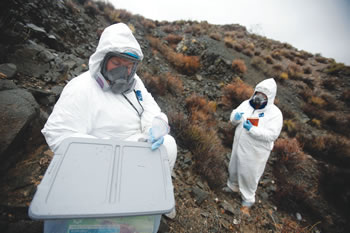A controversy in the wind
L-R: Geologists: Brenda Buck and Rodney Metcalf, take samples of rock in the desert near Henderson.
L-R: Geologists: Brenda Buck and Rodney Metcalf, take samples of rock in the desert near Henderson.
| credits: (Isaac Brekken/The New York Times)
For the past few years, geologists, Brenda Buck and Rodney Metcalf, have combed the wild terrain of southern Nevada, analyzing its stony dunes and rocky outcroppings — and to their dismay, tallying mounting evidence of a landscape filled with asbestos.
Asbestos occurs naturally in many parts of the country, mostly in the West but also along some mountain ranges in the East. But in Nevada, the scientists found, natural erosion and commercial development were sending the fibers into the wind.
Worried about the possible health risks, Buck and Metcalf, professors of geoscience at the University of Nevada, Las Vegas, reached out to experts in asbestos-related diseases.
With data from Nevada’s cancer registry, an epidemiologist prepared a preliminary report that outlining what she felt was a troubling pattern of mesothelioma — a cancer often related to asbestos exposure — among residents of the affected areas.
But if the scientists expected to be applauded by state officials for their initiative, they were mistaken.
Upon learning of the report, the Nevada Department of Health forced the epidemiologist, Francine Baumann of the University of Hawaii, to withdraw a presentation of the findings at a scientific conference and revoked her access to the state cancer registry.
Metcalf and Buck offered to meet with state officials but say they were rebuffed.
“In the years since, “no one from the health department has ever contacted us to ask for any information about the minerals,” Metcalf said.
So began one of the country’s more unsettling public health controversies.
Over the past several years, the researchers say, they have been vilified for making legitimate scientific inquiries that may have public health consequences.
Officials at the state health department counter that the researchers are simply wrong about the asbestos hazard and are promulgating an alarmist hypothesis.
The department’s own analysis has turned up no particular asbestos risks to residents, the officials say, pointing out that the incidence of mesothelioma in the state is well within the national average.
“Asbestos was there for hundreds, if not thousands, of years, and that has not translated into negative health effects,” said Dr. Ihsan Azzam, the state epidemiologist.
Naturally occurring asbestos deposits are not uncommon, and in past decades, particularly rich veins were mined for commercial use. It proved to be a dangerous occupation: Asbestos fibers travel easily through the air and are easily inhaled, scientists later found, embedding themselves in the lungs.
Once there, even in modest amounts, the fibers set off a cascade of inflammatory effects that can lead decades later to lung cancer, mesothelioma and other respiratory ailments.
One study conducted a few years ago found that one-fifth of the residents of Libby, Montana, the site of a large vermiculite mining operation, suffered asbestos-related lung diseases. Many never worked in the mines.
The Environmental Protection Agency designated the area a Superfund site in 2002 and, with the Department of Health and Human Services, declared a public health emergency there in 2009.
The growing body of research into asbestos exposure inspired Buck and Metcalf to take a closer look at their home state.
In October 2013, they published a study finding that natural asbestos-bearing mineral deposits were abundant in the region, from the southern shore of Lake Mead to the edges of the McCullough Range.
In a follow-up analysis, Metcalf and Buck reported that asbestos fibers around Boulder City and the eastern part of Henderson and Las Vegas were similar in shape and size to those sickening people in Libby.
And last month, the two geologists published a paper showing that a continuous swath of natural asbestos runs from Nevada into neighboring Arizona.
The findings have already had consequences. The Nevada Department of Transportation delayed construction of a $490m highway project, called the Boulder City Bypass, after learning that it would run through an area that the scientists had found to be rich in asbestos.
After seven months, an analysis concluded that while asbestos was ubiquitous in the area (found in all 150 soil samples), the levels were low enough for workers to proceed safely with the construction. Still, the state DOT plans to proceed with protective measures, such as watering down the roadbed and continual air monitoring.
Plans for a federal interstate highway connecting Las Vegas and Phoenix may also be affected. The suggested route would cut through the asbestos deposits in Arizona recently identified by Metcalf and Buck. No one has suggested that naturally occurring asbestos is causing an epidemic of cancer in southern Nevada.
The question is whether exposure to the mineral may be contributing in unrecognized, perhaps preventable ways.
In her original review of data from the state cancer registry, Baumann says she found an unusual number of mesothelioma cases in younger residents and in women in the affected areas.
The disease usually occurs in older men, after years of on-the-job exposure. Baumann thought the pattern she observed suggested an environmental exposure to asbestos at an early age. She submitted an abstract describing the research to the Geological Society of America and was to present it at the group’s national meeting in 2012.
But when the Nevada health department was alerted to the presentation, the state health officer, Dr. Tracey Green, invoked a clause in an agreement signed by Baumann, which allowed the health department to approve any scientific publication resulting from access granted to the state cancer registry. In a letter, Green demanded that the abstract be taken off the website, and the presentation was canceled.
New York Times Service








